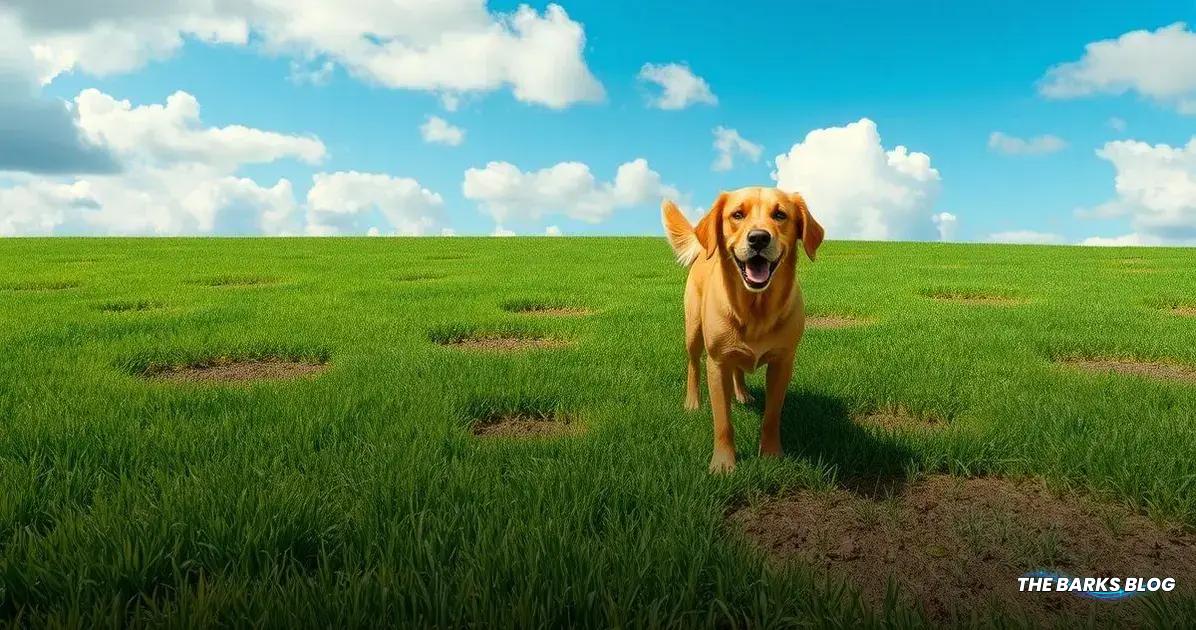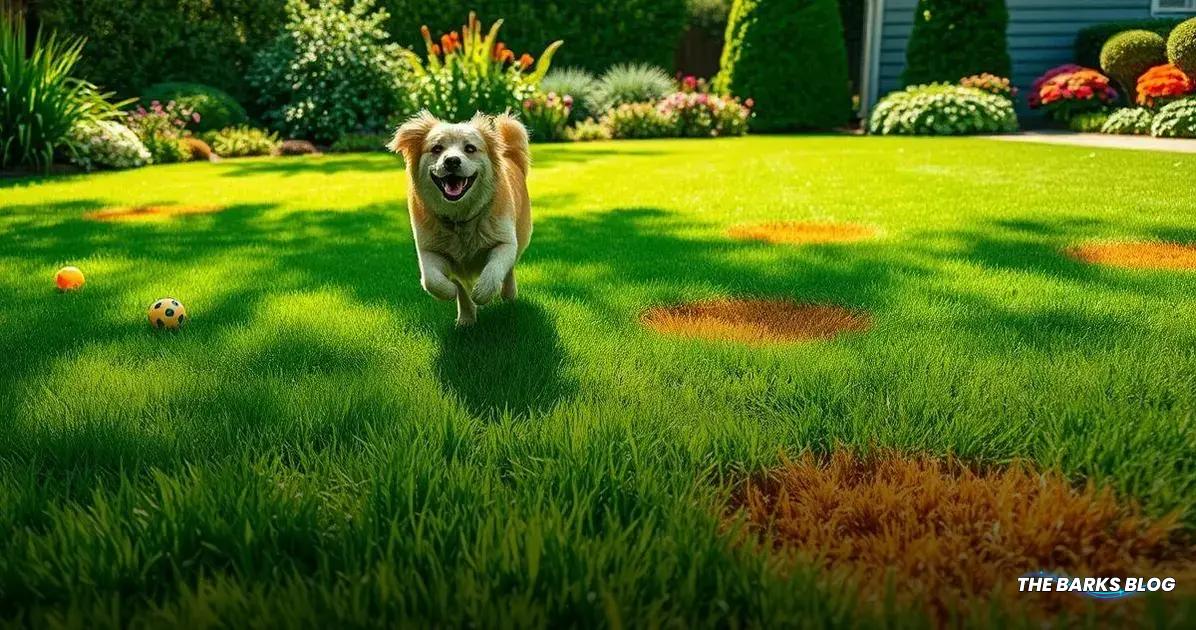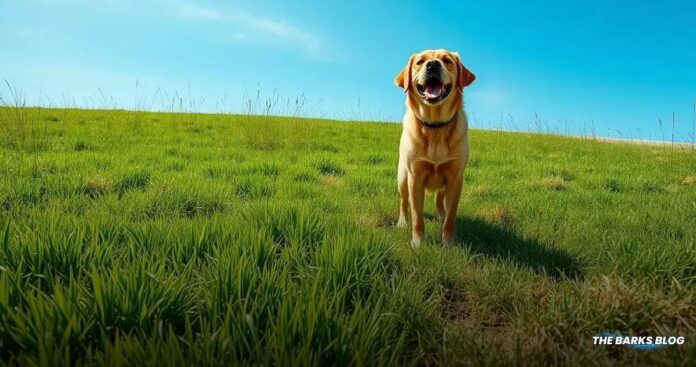Dog urine can create brown spots on lawns due to its nitrogen content, which can burn grass. To prevent this, pet owners can walk their dogs before they urinate, immediately clean up waste, hose down affected areas, increase water intake, use pee posts for male dogs, and choose low-nitrogen fertilizers. Additionally, planting urine-resistant ground covers and training dogs to use specific areas can help protect the lawn. While some may consider urine pH-altering supplements, these can be risky for pets and may not effectively resolve the issue. Regular watering is the best method to dilute nitrogen and keep the lawn healthy.
We love our pets to pieces, but we also love our yards to look their best. So, why is your dog’s pee turning your lawn brown?
Firstly, this is natural – there’s nothing wrong with your pooch. However, a dog’s waste contains nitrogen which comes about from the process of protein being broken down in the body.

Why Does Dog Pee Kill Grass?
Dog urine can wreak havoc on your lawn, and it all boils down to its chemical composition. When your furry friend relieves themselves on the grass, the nitrogen present in their urine can cause the grass to burn. This is because the nitrogen, while essential for plant growth in small amounts, becomes concentrated in dog pee, leading to a “burn” effect on the grass.
Interestingly, the grass surrounding the urine spot may actually appear greener. This is due to the fact that the roots of the grass can absorb some of the nutrients that are left behind in the urine. So, while one area might suffer from discoloration, another might thrive!
It’s also worth noting that both male and female dogs produce urine that can damage grass. The difference in urine composition between the sexes is negligible when it comes to lawn care. Therefore, regardless of whether you have a male or female dog, you’ll need to manage their bathroom habits to keep your lawn healthy.
In summary, the nitrogen and other compounds in dog urine are the main culprits behind the browning of your grass. Understanding this can help you take steps to mitigate the damage and keep your lawn looking its best!

How To Combat Brown Spots In Grass From Dog Pee
Dealing with brown spots on your lawn caused by dog pee can be frustrating, but there are several effective strategies you can implement to restore your grass to its lush, green glory.
1. Walk Your Pup First Thing in the Morning: Start your day by taking your dog for a walk before they have a chance to relieve themselves on your lawn. This simple change can help prevent those pesky brown spots from appearing.
2. Pick Up Their Poop Immediately: The longer you leave dog waste on your lawn, the more damage it can cause. Make it a habit to clean up after your dog right away, and consider using biodegradable poop bags for an eco-friendly option.
3. Hose Down the Patch After They Pee: After your dog pees, take a moment to water down the area. Using a hose, watering can, or even a glass of water can help dilute the urine and lessen its impact on the grass. Regularly watering your lawn helps keep any chemicals from accumulating.
4. Increase Their Water Intake: Consider adjusting your dog’s diet to include more wet food or ensuring they have constant access to fresh water. A well-hydrated dog will produce more diluted urine, which is less likely to harm your lawn.
5. Invest in a “Pee Post”: If you have a male dog, consider installing a pee post in your yard. These posts encourage your dog to pee on them instead of the grass, helping to protect your lawn.
6. Use Low Nitrogen Fertilizers: If you fertilize your lawn, switch to a low nitrogen brand. This will help reduce the overall nitrogen levels in your grass, making it less susceptible to damage from dog urine.
7. Plant Urine-Resistant Ground Cover: Consider planting a more resilient ground cover like clover, rye, or fescue in areas where your dog frequently pees. These types of grass are known to be more resistant to urine damage.
8. Train Your Dog to Pee in a Designated Area: Using positive reinforcement, you can train your dog to relieve themselves in a specific spot. Reward them when they use the designated area and be patient during the training process.
By implementing these strategies, you can effectively combat the brown spots caused by dog pee and maintain a vibrant lawn that both you and your furry friend can enjoy!

Would Supplements Help with Lawn Damage?
When it comes to addressing lawn damage caused by dog urine, many pet owners wonder if supplements can help mitigate the effects. The short answer is: no, supplements are not a viable solution.
Some products claim to alter the pH levels of your dog’s urine to prevent it from damaging your grass. However, these supplements can lead to health issues for your dog, including bladder stones and potential infections. It’s crucial to prioritize your pet’s health over cosmetic lawn fixes.
Additionally, you may have heard of products known as “dog rocks” or similar items that promise to reduce lawn damage. While some brands may claim to help, it’s essential to approach these products with caution. Always buy from reputable brands, conduct thorough research, and seek out trustworthy reviews. Consulting your veterinarian before trying any new supplement is also a wise choice.
Keep in mind that your lawn may not only be affected by your dog’s urine. Other neighborhood animals could also contribute to the problem. Therefore, the most effective solution remains consistent watering. Regularly hosing down the grass can help dilute the nitrogen from your dog’s, or any other animal’s, waste, minimizing damage and keeping your lawn healthy.
In conclusion, while the idea of using supplements to combat lawn damage may seem appealing, it’s best to focus on natural remedies and proactive measures to protect your grass and ensure your dog’s health.
Conclusion
Maintaining a beautiful lawn while accommodating your furry friend can be a challenge, especially when it comes to the effects of dog urine. Understanding why dog pee turns grass brown and implementing effective strategies can make a significant difference.
By taking proactive measures like adjusting your dog’s bathroom habits, increasing their water intake, and using urine-resistant plants, you can keep your lawn looking lush and green.
While supplements may seem like an easy fix, they can pose health risks to your dog without effectively addressing the issue. Instead, focus on natural solutions, such as regular watering and training your dog to use designated areas. With patience and the right approach, you can enjoy a healthy, vibrant lawn that both you and your pet can appreciate.
FAQ – Frequently Asked Questions about Dog Urine and Lawn Care
Why does dog pee turn grass brown?
Dog urine contains high levels of nitrogen, which can burn the grass when concentrated in one spot, leading to brown patches.
Does it matter if my dog is male or female regarding lawn damage?
No, both male and female dogs produce urine that can damage grass, so the sex of your dog does not affect the outcome.
What can I do to prevent brown spots on my lawn?
You can prevent brown spots by taking your dog for walks before they relieve themselves, watering the affected areas immediately, and increasing their water intake.
Are there any specific plants that are more resistant to dog urine?
Yes, planting urine-resistant ground covers like clover, rye, or fescue can help as they are more resilient to urine damage.
Can supplements help my dog’s urine from damaging the lawn?
No, supplements that claim to alter urine pH can cause health issues for your dog and are not effective in protecting your lawn.
How often should I water my lawn to mitigate dog urine damage?
Regular watering is key; aim to water your lawn frequently, especially after your dog pees, to help dilute the nitrogen and minimize damage.




